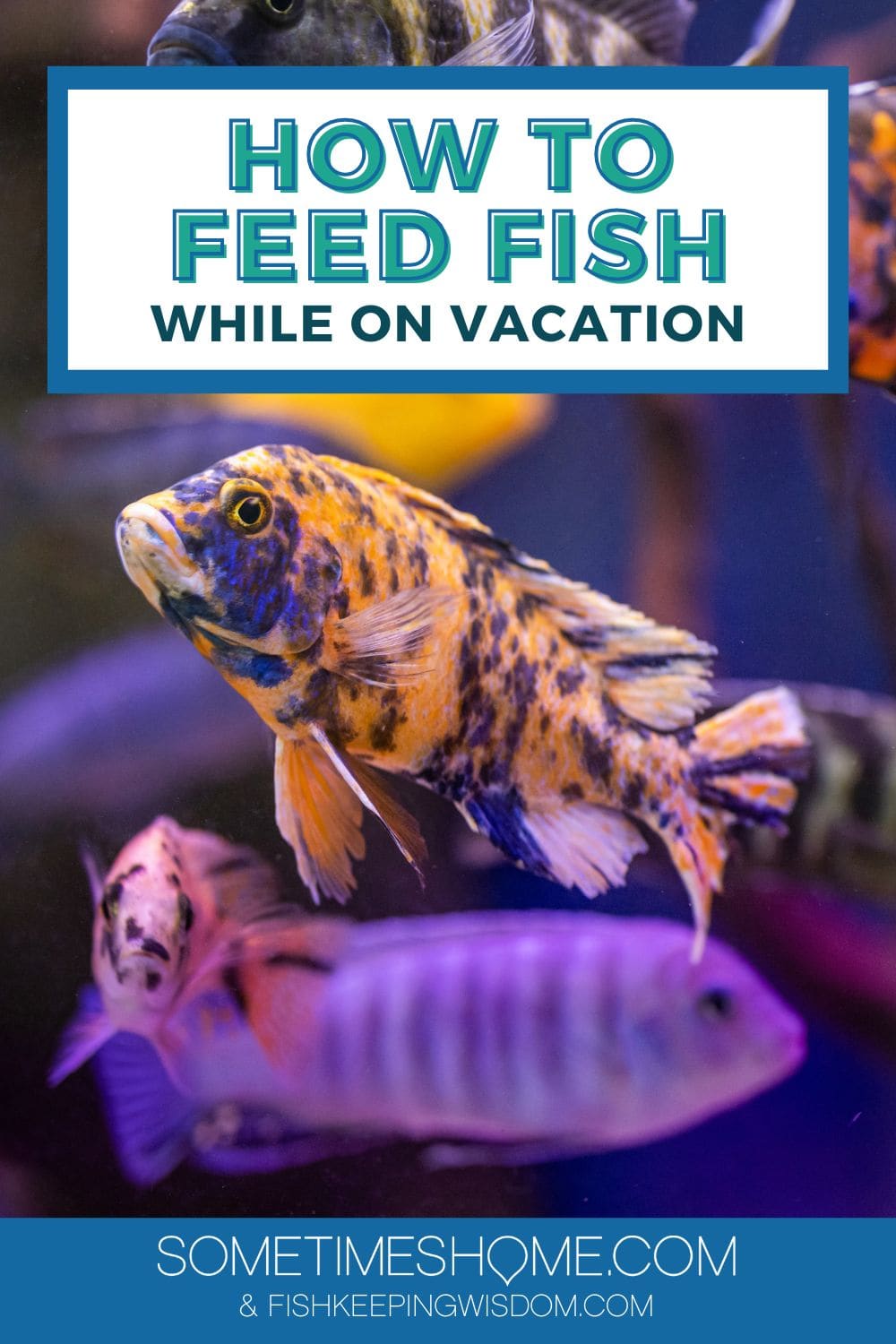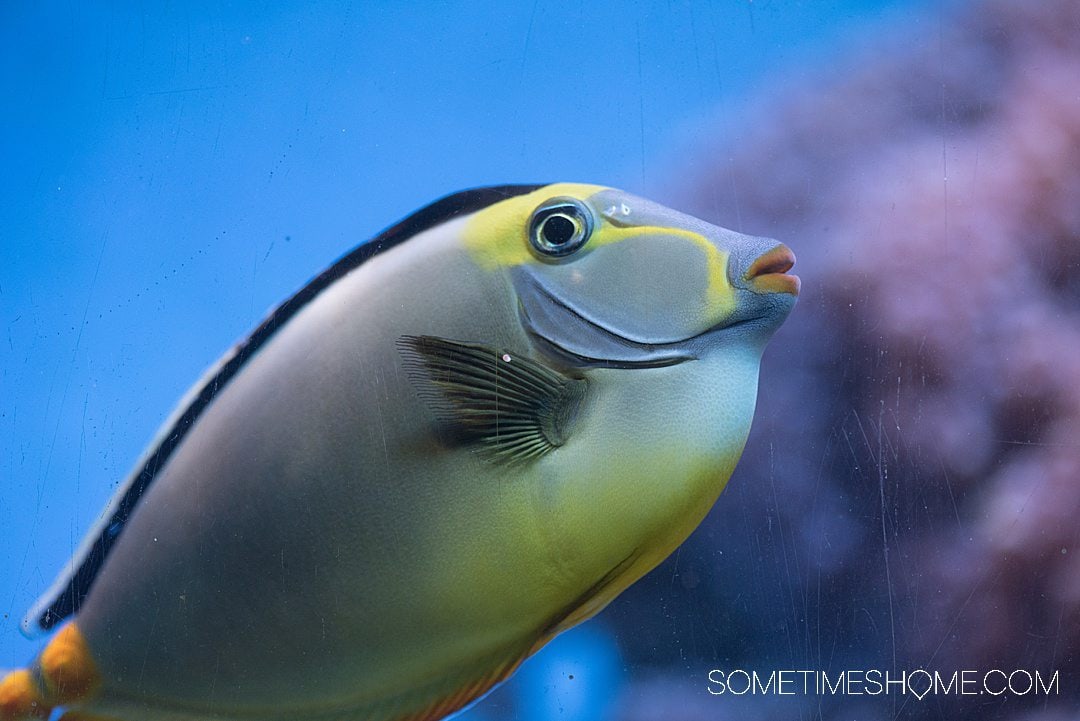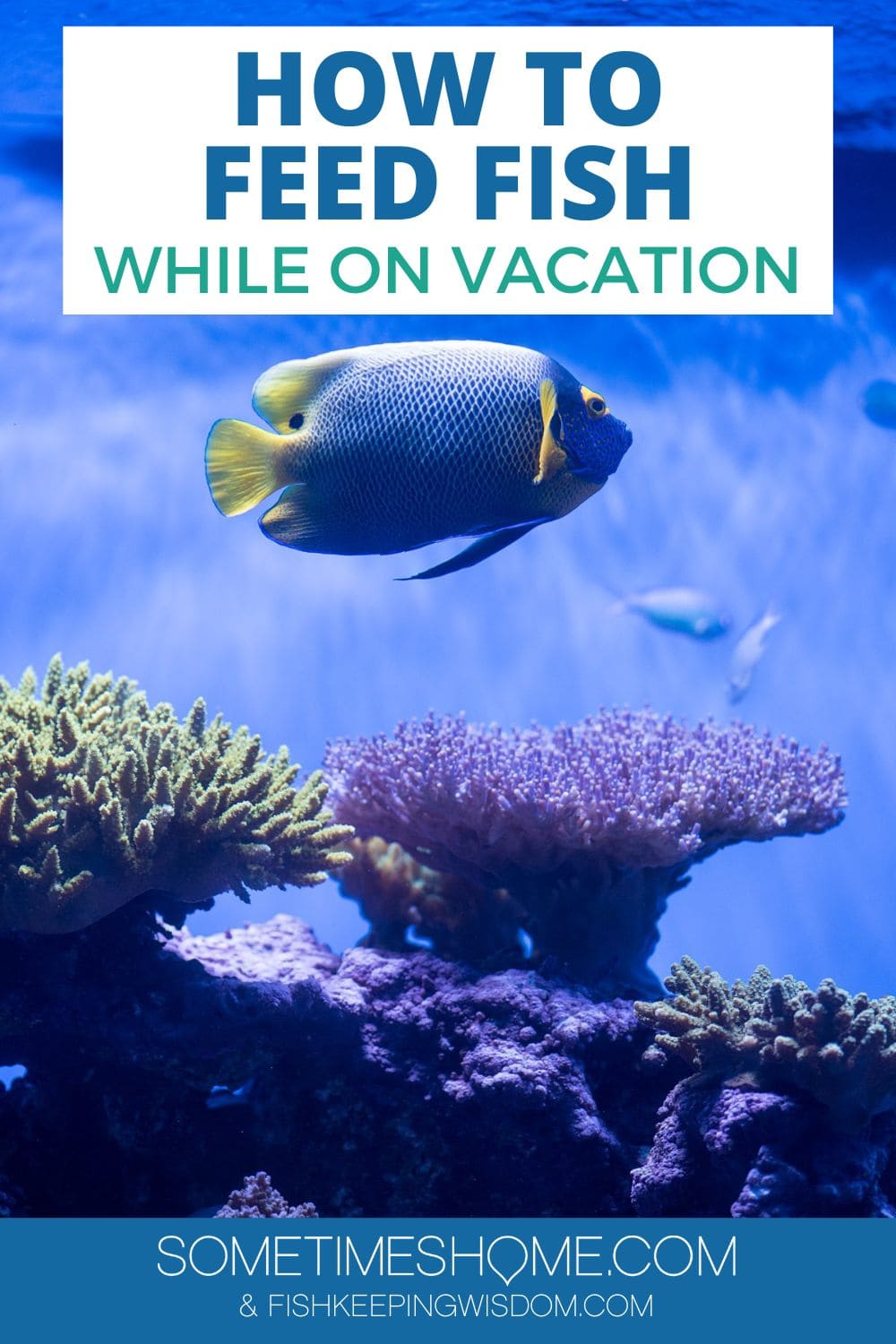How to Feed Fish While on Vacation: Tips, Tricks + Strategies
There’s nothing like a short or long vacation from your place to shake things up! But owning fish means vacation plans become more complicated. Therefore, knowing how to feed fish while on vacation is important.
Disclosure: This post has affiliate links, meaning we may earn a small commission if you click the link and proceed with a purchase at no cost to you. We recommend experiences, hotels, products, and services we use and support.
Written by Brett Schiller

Ways to Feed Fish While You Travel
Food is critical to a fish’s health. Stress, disease, and starvation are inevitable without regularly feeding your fish. So what strategies exist to feed your fish so you can go on vacation without worry?
There are several effective ways to feed your fish while you’re on vacation:
Which of these methods is best for your fish tank? We’ll cover each one of these below.
More of a visual learner? This video breaks down most of the tips I discuss as well:Automatic Fish Feeders
The most reliable way to keep your fish fed is to use automatic fish feeders. The pros are many: you don’t have to schedule and pay for a fish sitter to come by daily. That means less coordination, fewer people, and no key handovers.
When you return, an automatic fish feeder can even be a regular part of owning a fish tank. That way, your fish get a regular feeding schedule even when you are at work. Multiple small meals are healthier for most fish than one or two large feedings per day.
When calibrated right, automatic fish feeders won’t overfeed and foul your tank water. Fish also don’t have to adjust to a new schedule. You can set them to feed fish whenever you normally would.
Programmable Fish Feeder
The FREESEA Aquarium Automatic Fish Feeder is programmable, allowing you to dispense a precise amount of flakes or pellets for fish diets. Battery-operated models are best, so fish food won't be impacted even if the power goes out.
The only real negative is that most automatic food dispenser models don’t allow you to vary the type of food. They have a single dispensing chamber so your fish will eat the same thing daily.
There are some exceptions, however. The Fish Mate F14 Aquarium Fish Feeder has separate chambers for each day. So you can add freeze-dried krill one day, flakes the next, and so on!
That said, having to eat the same food for one or two weeks won’t cause stress to most fish. It’s a bland diet but will keep your fish fed until you return to offer more fat, proteins, and other missing micronutrients.
Feeder Blocks
Aquarium vacation feeder blocks are one of the oldest strategies and can be found at any fish store. These are made of fish food pressed into solid blocks.
Over time they slowly release fish food, softening with water contact so tropical fish can nibble away at the block whenever they want.
Tetra Weekend Slow Release Fish Food is a brand favorite. They are made of the same high-quality ingredients used in their flake and pellet fish food formulas, unlike some other brands that use plaster, starch, and other fillers to slow down water absorption.
Feeder blocks are inexpensive and by far the easiest solution for how to feed fish while on vacation. Just drop one into your fish tank and go!
Calibrating an automatic fish feeder or coordinating with family or fish sitters is unnecessary when you have a feeder block. That said, there are a couple of downsides to consider before buying a vacation feeder block.

Feed Blocks Pros and Cons
The first downside of fish feeder blocks is that you can’t tailor the diet to meet the needs of all of your fish. If you have a general community tank, all the fish probably eat the same food. So no problems here.
But what about tanks with herbivores, omnivores, and carnivores? Carnivorous and herbivorous fish may not get the nutrition they need from vacation feeders.
Many might not even recognize the vacation feeder as a source of food. If it doesn’t move or smell right, some fish will starve before ever trying to eat from one.
Predatory fish that focus on movement are the least likely to feed from a feeding block or gel block of food.
Another problem can arise if you have aggressive or territorial fish. It may be hard to ensure shy or peaceful fish get to eat while you are gone. An aggressive species like a cichlid, red-tailed shark, or catfish may bully other fish when they try to pick at the feeder block.
Adding multiple feeder blocks can work to curb aggression. But that makes the next problem even worse: water quality.
Feeder blocks slow-release fish food, but fish aren’t the only things eating it. Bacteria and other germs will rot softened, excess food. And unlike fish, bacteria don’t really get full. This causes ammonia levels in the aquarium to rise steadily while you’re gone.
This won’t be a huge problem in a well-cycled fish tank. Your beneficial bacteria will reproduce when there is more food. Increasing their numbers to make up for the higher ammonia levels.
Their reproductive cycle takes a few days, though. If your tank already has poor water quality, you may come home to dying fish suffering from ammonia or nitrite poisoning.
So think carefully about feeder blocks. They are a good solution but do come with some downsides.
Hire a Fish Sitter
The most reliable way to feed your fish is to hire a pet sitter. This is someone who comes by and places fish food in the tank. The schedule is one mutually agreed upon: once per day is the simplest solution. Even baby fish will be fine with a single meal per day.
You can even have them come every other day. Your fish won’t starve even if fed every other day for a couple of weeks.
Fish Owners Who Pet Sit
We recommend choosing people who are fish keepers as your fish sitter.
Fish food isn’t hard to dispense, but it’s the added experience fish keepers have that makes them a good choice. They can monitor your fish for signs of stress or disease.
A professional fish sitter can dose medications and call you if they see an issue. They can even perform tank maintenance if you can convince them (or pay them enough).
Pet Sitters Who are Non-Fish Owners
People who don’t keep aquatic pets can still feed your fish. Most of us have had a family member add a few flakes or pellets to the tank when we’re not around. Family is also easier to trust when we go on vacation for an extended period.
But there is a good chance they might overfeed if you don’t educate them beforehand. And if your fish show stress or poor physical condition, the problem may go unrecognized during your vacation.
Aquarium Live Foods
Instead of a food dispenser or fish sitter, some aquarists go with placing a lot of live food into the aquarium. Live food remains fresh over an extended period.
Many fish will pig out, but live food isn’t always easy to catch. They will get enough food to stay healthy and full while you leave town for a short trip.
The main issue with live food is that the type of fish and tank environment matters a lot. Brine shrimp can’t live in a freshwater fish tank. And even if you add them to a reef tank, they will get sucked up into the filter or protein skimmer.
Tubifex worms are a good choice in live food for freshwater tanks. They burrow into the substrate, preventing your fish from eating all of them. But they come to the surface, especially when light levels are low in the morning and evening.
Fish can then pick them off. Even picky eaters love fat-rich tubifex worms. Large, carnivorous fish are the easiest to feed. Ghost shrimp, rosy red minnows, feeder guppies, and goldfish are all good options. The extra food will last a week or more while you are away.
How Long Can Fish Go Without Food?
Fish healthy and disease-free can go a surprisingly long time without food. Most will live for two to three weeks or even a couple of months before dying of starvation. The exact length of time depends on the species and diet of your freshwater fish. As well as their metabolism.
Small, active fish need to be fed the most often. Tetras, guppies, cherry barbs, danios..All of these aquarium fish should go no longer than three days as sunken bellies will show up fast. But they will live for up to 2 weeks before starving.
Betta fish, gouramis, cichlids, and other fish with a moderate metabolism will show no signs of stress for 5 to 7 days without food. Bettas will live for up to 2 weeks before starvation becomes an issue. And larger fish will live for up to 3 weeks.
| Common Aquarium Fish | Days They Can Live Without Food |
| Betta Fish | 1 to 2 weeks |
| Guppies, Tetras, And Other Small Community Fish | 1 to 2 weeks |
| Gouramis And Other Medium Sized Fish | 2 to 3 weeks |
| Cichlids, Arowanas, And Other Large Predators | Up to 3 weeks |
African Lungfish: Fish That Can Survive Record-holding Time Periods Without Food
Some fish can go for extremely long periods without food. The world record holder is the African lungfish (Protopterus annectens). They live in regions where bodies of water dry up seasonally.
The African lungfish digs in when the water turns to mud and food become scarce. Next, it secretes a mucus cocoon to hold in what moisture is left. It then hibernates, using stored fat to wait up to four years before the rains (and food) return.
Can I Not Feed My Fish?
For vacations of a short duration (one to three days), you can skip feeding fish altogether! No fish needs to eat so often that it will starve in one to three days. Missing a few meals will not cause them any serious stress.
Fish keepers will be greeted enthusiastically when they return home. But there will be no starving fish.
If your vacation will be longer than three days, use one of the above strategies to feed your fish while you're on vacation. Otherwise, most fish will start to become stressed from a lack of nourishment.
Starvation and ill health still take more than a week of no food to set in. But we don’t want our pets to go longer than three days without meals.
One exception is if you are keeping baby fish. Babies don’t have the fat stores that adult fish do. They are growing constantly and need to be eating daily. More than one missed meal can result in stunted growth. And even death in newly hatched fish fry.
So long as you don’t have picky fish, a weekend trip without food won’t be an issue! But how do we keep baby fish fed?
Feeding Baby Fish While On Vacation
Fish fry and other babies often prefer live food over fresh or prepared food. Newly hatched fish are actually some of the easiest to feed. Fish breeders typically move the fry over to a rearing tank after hatch.
These aquariums have a sponge filter, which won’t suck up the fry. You can also add a cloud of live infusoria to the tank. Infusoria are hardy and feed on suspended organic matter, algae, and each other.
They will provide at least a week’s worth of food for your baby fish. If you have a fry-rearing tank that has plant growth and a mature substrate, infusoria can grow there indefinitely!
Things To Do For Your Fish Before Leaving For Vacation
Before you leave for vacation, you should perform a few extra maintenance steps. That way, you’ll be sure to come home to happy fish!
We go into detail about each checklist item below.
Check Water Quality
Monitoring water quality is an essential part of regular aquarium maintenance. So you may not need to deviate too much from your usual schedule.
pH, ammonia, nitrite, and nitrate levels should all be measured a few days beforehand. As well as shortly before you leave. If a dead fish hidden behind some rocks dies, it will release a plume of nitrogenous waste.
Your test kits will alert you, helping you solve the issue before it can become a problem.
Set Up the Automatic Fish Feeder Before You Leave
Don’t wait until the last day to program or plug in your automatic fish feeder. The unit could be defective and need replacement. The directions for programming it might be complicated. And so on…
Make sure you have it running and calibrated a few days beforehand. Let it feed your fish while you are present. That way, you can be sure it is dispensing food on time and in the right amounts.
Perform a Water Change
Once you double-check your water quality, it’s time for a water change! Even if levels seem pristine, small to moderate water changes help refresh your tank's ecosystem.
I recommend 10 to 30%, depending on the size of your aquarium. As well as how long it’s been since the last water change. A gravel vacuum, bucket, and tap water conditioner is all that’s required.
Remove the hood and turn off the lights. Shut down the power filter and possibly the heater, depending on how low the heating elements are in the water.
If the heater elements will be exposed during water changes, turn it off. Otherwise, the glass will get hot and crack if splashed with tank water.
Get water flowing into your gravity-powered gravel vacuum, digging deep into the substrate to remove any leftover food and fish waste. All of this waste will cause ammonia, nitrite, and nitrate levels to rise while you’re not home.
Once you’ve gotten all of it, dump the dirty water. Then refill the bucket with tap water treated with water de-chlorinator to remove chlorine and chloramines.
Make sure that your tap water temperature is as close to your aquarium’s water as possible using a thermometer. Differences of 3-5°F can be stressful or even fatal to sensitive fish species.
Gently add the treated and warmed water to the tank. Avoid adding so much that fish are blasted by incoming water.
Top Off the Aquarium
If you do a water change, the natural end goal is topping off the tank. But maybe you’re reading this article right before you have to leave. If so, then take a moment and add warmed, treated tap water to the aquarium!
While you are away, water levels will drop due to evaporation. Anything that agitates the surface, like the outflow of a power filter or aeration stone, will speed up this process.
As water evaporates and the level drops, aquarium technology can get exposed. If your filter runs out of water to pull in, the motor can overheat and burn out. Water-cooled devices can even catch fire. As explained above, heaters will crack if the glass is allowed to get hot.
As water evaporates, the chemicals contained in it also become more concentrated. If your water is mineral-rich, the pH levels will rise. Salt levels increase. As does the concentration of ammonia, nitrite, and nitrate.
This is because when water evaporates, it leaves all of the stuff dissolved in it behind.
Look For Signs of Stress or Disease
When you feed your fish or are just watching them for enjoyment, take a moment to study their behavior. Do you see any signs of injuries, stress, or diseases? Stress stripes, clamped fins, open wounds, hiding, lack of appetite, white spots…Anything that looks out of the ordinary.
If you suspect your fish has a health issue, identify it and do research to see whether it is an issue that can wait for your return.
You may need to notify or leave specific instructions to your fish sitter. Directions on any medicines to add or preventative measures to take can mean the difference between life and death for your fish.
Even while you are on vacation, check with a fish sitter from time to time. See if they recognize any signs of stress or disease and offer advice as needed.
Put the Aquarium Lights on a Timer
An aquarium light timer unit is good to have, even if you aren’t on vacation.
Fish and plants are creatures of habit. Just like us humans, regular day/night cycles help aquatic organisms regulate their body clocks.
Plants grow more effectively since they can prepare for lights to turn on and shut off at the right intervals. And fish will get better sleep and remain healthier.
Some higher-end aquarium lights come with a timer built in. This is most common with LED plant/viewing lights like those made by Nicrew. But they also make general aquarium light timers for LED fixtures that have standard 2.5mm/2.1mm power connectors.
If you don’t have live plants, turning the light levels down will save power. No one will be around watching your fish. And most fish prefer lights that aren’t too bright.
Plus, you won’t be fueling algae growth with the excess light! Green water algae blooms easily happen if the lights stay on for too long and your sitter overfeeds while you are on vacation.
Get a Surge Protector
Do you live in an area prone to thunderstorms, brownouts, or power surges? A power strip with a built-in surge protector should be on your shopping list. Power surges can fry unprotected heaters, filters, protein skimmers, and lights in one go.
Power strips with surge protectors are a very inexpensive measure of protection. And ensure your aquarium technology stays safe and running while you’re on vacation.
Trim Dead Plant Leaves
Use your aquarium plant maintenance tools to trim any dead or dying growth as a final pre-measure. Plant scissors are razor sharp, have long handles so your fingers stay dry, and are angled so its easier to reach leaves and stems.
Don’t use kitchen or paper scissors to trim aquarium plants. They are too dull and crush plant matter, which makes it easier for bacteria to infect them. Plus, the scissors tend to rust if allows to remain wet.
By removing dead plant matter, you are preventing them from decaying while you are away. Dead leaves will cause small increases in nitrogenous waste levels.
They aren’t as bad as dead fish or other rich sources of protein. But they still cause water quality to decrease.
Conclusion
Whether you are leaving for two days, two weeks, or two months, you need to have your aquarium in order. That goes well beyond making sure your fish get fed.
Pre-vacation maintenance will keep water quality excellent. Ensuring no problems or dead fish are around to greet you when you return home!
🐠 Head over to Fishkeeping Wisdom to download their free Fishkeeping Guide!
This article originally appeared on Fishkeeping Wisdom and was syndicated to Sometimes Home.




